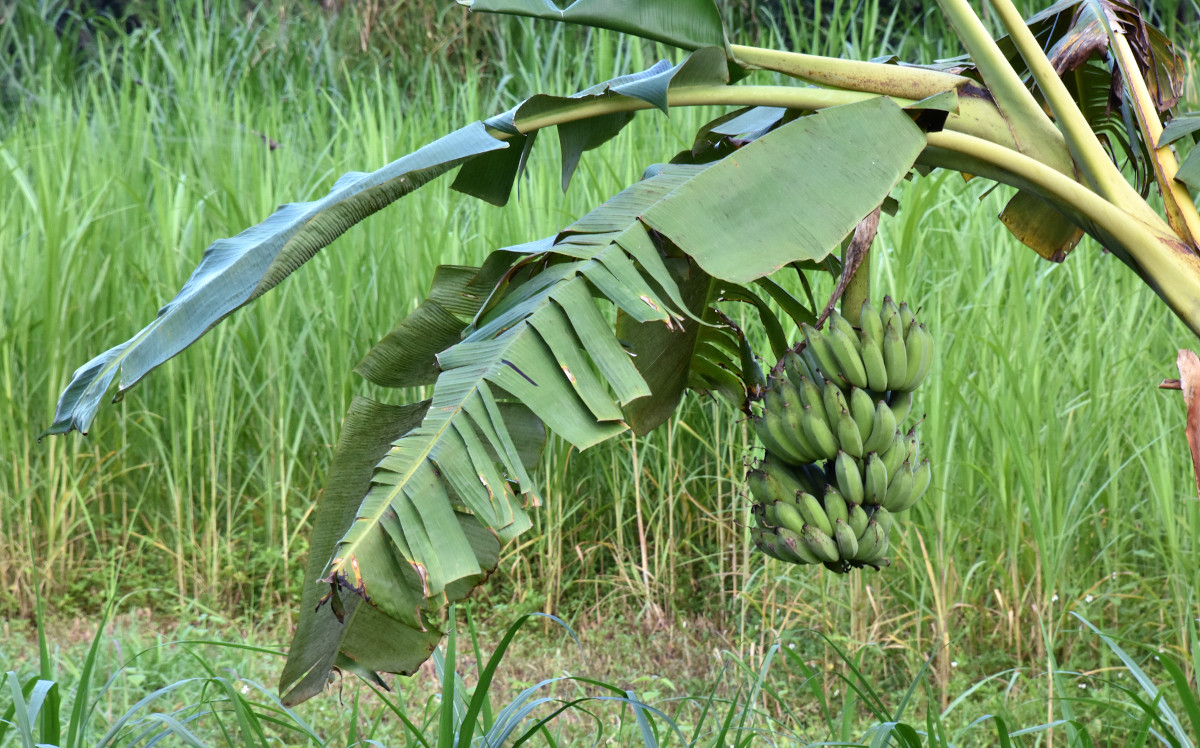Musa × paradisiaca L. - Musa dacca Horan.; Musa ×paradisiaca var. dacca (Horan.) Baker ex K.Schum, Musa × sapientum L.. - Musaceae
banana, Banane, Dessertbanane
„= M. acuminata × M. balbisiana, or Musa AB, AAB, ABB, ABBB, AAAB, AABB Groups: hybrid forms of edible bananas and plantains“
http://www.ars-grin.gov/cgi-bin/npgs/html/taxon.pl?70453
„The above-ground part of the plant is a „false stem“ or pseudostem, consisting of leaves and their fused bases. Each pseudostem can produce a single flowering stem. After fruiting, the pseudostem dies, but offshoots may develop from the base of the plant. Cultivars of M. × paradisiaca are usually sterile, without seeds or viable pollen.“ wikipedia
„The characteristic “banana-like” flavor is due to the amyl esters of acetic, propionic, and butyric acids. The distinctive “fruity” and “estery” notes are attributed to butyl acetate, butyl butyrate, hexyl acetate, and amyl butyrate.“
[Correlation of Gas Chromatographic Data with Flavor Profiles of Fresh Banana Fruita., McCarthy, A.I., Palmer, J.K., Shaw, C.P., Anderson, E.E., Journal of Food Science, Vol.28(4), 1963, 379-384]
„Using headspace solid-phase microextraction and gas chromatography-mass spectrometry to characterize volatile compound found that the flavor 20 volatile compounds (11 esters, 5 alcohols, 3 carbonyls and 1 ketone) are varied on Hom Thong maturity stage. The compounds with the most aroma impact for ripe Hom Thong flesh at stage 6-8 were 3-methylbutyl butanoate, 3-methyl-1-butyl acetate (isoamyl acetate), 3-methylbutyl 3-methylbutanoate and 2-methylpropyl ethanoate.“
[Physicochemical and flavor changes of fragrant banana (Musa acuminata AAA group “Gross Michel”) during ripening., Thaiphanit, S., Anprung, P., Journal of Food Processing and Preservation, Vol.34(3), 2010, 366-382]
„Ethyl esters were found to comprise the largest chemical class in the bananas from studied cultivars, accounting 80.9%, 86.5%, 1.2%, 90.1% and 6.1% for the volatile fraction in Dwarf Cavendish, Prata, Ouro, Maçã and Platano varieties, respectively. As found for bananas from Ouro cultivar (50.0%), 3-methylbutyl butyrate was found to be the most abundant volatile metabolite in bananas from Dwarf Cavendish (28.3%), Prata (37.8%) and Maçã (34.4%) cultivars, while isoamyl acetate (27.6%) occur as the major volatile metabolite in bananas from Platano cultivar.“
[Dynamic headspace solid-phase microextraction combined with one-dimensional gas chromatography-mass spectrometry as a powerful tool to differentiate banana cultivars based on their volatile metabolite profile., Pontes, M., Pereira, J., Câmara, J.S., Food chemistry, Vol.134(4), 2012, 2509-2520]
Main compounds found in the headspace of whole bananas were 3-methyl-1-butyl acetate (isoamyl acetate), 3-methyl-2-butyl acetate, isopentyl 2-methylpropanoate (isoamyl isobutyrate), 3-methylbutyl butyrate (isoamyl butyrate), and 3-methylbutan-1-ol (isoamyl alcohol). Overripe fruits (day 4-10) were characterized by higher amounts of isobutyl butyrate and isoamyl butyrate.
[Ragubeer, Charlene. The emission of volatile organic compounds (VOCs) from rotting fruits and wilting flowers. Diss. 2015] PDF

Musa paradisiaca L., Buchoz, P.J., Histoire universelle du règne végétal, vol. 1: t. 59 (1775-1778)
plantgenera.org

Musa × paradisiaca, Buon Ma Thuot, Dak Lak, Vietnam (2017) © Doug W CC BY-SA 4.0 inaturalist.org

